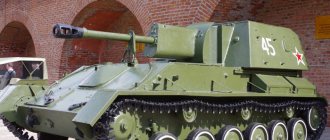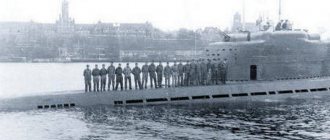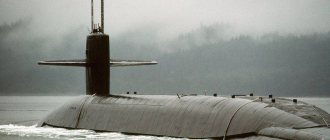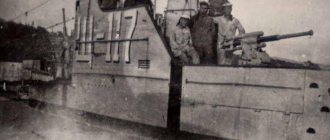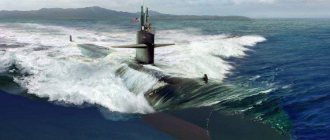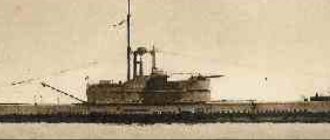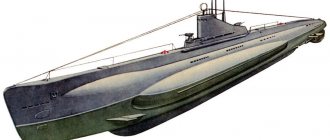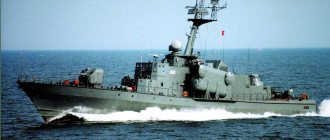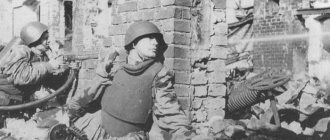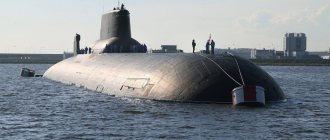Submarines of the "Stalinets" type. The best Soviet submarines of the Great Patriotic War
Experts consider submarines of the “C” type, also known as “Medium”, also known as “Stalinets” (the general name for boats of the series built) to be the best Soviet submarines of the Great Patriotic War. For the Navy of the Soviet Union, 41 such boats of two series were built - IX, IX-bis. The submarines were built from 1936 to 1948. The basis for all boats in the series was a project that was developed by order of the Soviet side by the German-Dutch design bureau “IVS”. By the beginning of the war, 17 submarines of this type were put into operation, another 17 entered the fleet during the war, and another 7, which were afloat by June 22, 1941, entered service after the end of the Great Patriotic War.
In 1932, a group of Soviet submarine specialists arrived in The Hague, their goal was to visit the IVS design bureau. This design bureau was located in Holland, but belonged to the famous German engineering concern Deshimag and was almost entirely staffed by highly qualified German specialists who had extensive experience in the design and construction of submarines in the First World War. The main purpose of creating this company was to preserve valuable personnel for Germany for that period of time while the country was prohibited from creating its own submarine forces under the terms of the Treaty of Versailles. By the time the Soviet delegation visited the enterprise, the design bureau had already managed to make a name for itself with successful submarine projects for Finland, Japan and Spain. The project of the boat for Spain “E1” was of interest to the Soviet side, and tests carried out in Cartagena with the presence of the Soviet delegation confirmed the characteristics of the boat and made a good impression.
In April 1933, an agreement was signed on the design of a new submarine for the USSR based on the Spanish “E1”, but with Soviet weapons and mechanisms. The development was designated "E2" and was carried out in Bremen with the participation of several Soviet specialists. In January 1934, the project of a new boat was presented to the leadership of the People's Commissariat of Heavy Industry and the command of the USSR Navy. The technical design of the future submarine was approved and accepted for laying down for the Soviet fleet in a large series. The project was given the number IX and the letter designation “N” (German), later replaced by “C” (medium, which gradually transformed into “Stalinist” in accordance with the accepted fashion of naming samples of military equipment in honor of the leaders of the country and the party). Working drawings of the boat, which were approved by employees, were completed in early 1935.
S-1 during sea trials. The bow gun is not installed, but its fence in front of the wheelhouse is clearly visible
The construction of the first three boats of the IX series was carried out at the Baltic Shipyard; these boats were equipped with imported equipment and mechanisms. During the construction and operation of the first two boats, shortcomings were identified: a shortfall of 0.5 knots of the design surface speed, vibration of periscopes at full speed, frequent scuffing of diesel engine pistons and other comments. It also became obvious that it was impossible to build a large series of ships with the expectation of installing foreign equipment, since its timely delivery could not be guaranteed. Thus, for the submarine IX series C-3, diesel engines from the German company MAN and other technical equipment were received almost two years late. In this regard, a clear and absolutely correct decision was made to rework the design of the IX series submarine, eliminating the identified shortcomings and replacing foreign equipment with Soviet equipment.
This is how the IX-bis series submarine project was born. It was she who became the most massive, 38 ships were completed, the construction and commissioning of which dragged on for many years due to the outbreak of the war. The diesel power plant underwent the greatest changes in the project. Especially for the boat, under the leadership of N. M. Urvantsev, a new four-stroke eight-cylinder non-reversible diesel engine 1D was developed at the Kolomensky Plant, the diesel power remained the same 2000 hp (at 470 rpm), and the speed characteristics of the “Esok” remained unchanged. At the same time, the installation of new engines required increasing the diameter of the exhaust pipes from 360 to 420 mm and reworking the oil, water, air, and fuel systems. In addition to this, the changes also affected the design of the wheelhouse: the shields that covered the 100-mm gun interfered with the work of the artillery crew, so it was decided to abandon them. At the same time, on three boats of the IX series, the fence was also dismantled. The changes made to the project were successful, as they allowed us to maintain the main tactical and technical characteristics of the boat, solving a number of important problems.
In terms of architecture, the submarines of the IX and IX-bis series were one-and-a-half-hull submarines of mixed design, in which the strong hull was riveted and the lightweight one was welded. In the process of serial production of boats, the volume of welded structures increased. Starting with the S-21 boat, the manufacture of a durable ship hull was also carried out using this technology. The design of the boat's durable hull was distinguished by a high level of manufacturability, primarily due to the refusal to space joints and grooves and work to simplify the shape of conical and cylindrical sections. The boat's durable deckhouse had an oval shape, which reduced its width and water resistance when moving submerged. A permeable (that is, filled with sea water) superstructure rose above the strong hull of the boat.
The boat was divided into seven compartments, three of which were shelter compartments; they were separated by special spherical waterproof bulkheads, which were designed for a pressure of 10 atmospheres. This was the first time such a hull arrangement was used in the Soviet fleet. From the bow to the stern of the boat, the compartments were distributed as follows: the first shelter compartment: torpedo room, living quarters for enlisted personnel; second compartment: battery, 62 elements of the bow group of batteries, officers' living quarters and the boat commander's cabin; third compartment-shelter: central post, above the compartment there was a conning tower, as well as a fence for retractable devices; fourth compartment: battery, 62 elements of the aft battery group, living quarters for foremen; fifth compartment: diesel; sixth compartment: electric motor; seventh shelter compartment: torpedo room, living quarters for enlisted personnel.
The crew of the C-type submarines consisted of 45 people: 8 officers, 16 petty officers and 21 privates. Later, during the war years, on some submarines the crew size increased by another 1-2 people. This was due to the need for additional operators of acoustic and radio equipment.
The power plant of diesel-electric submarines of the Stalinets type consisted of two surface-mounted diesel engines of type 1D produced by the Kolomna Plant, developing a power of 2000 hp. each and two electric motors type PG-72/35 with a power of 550 hp. at 275 rpm. In addition, there were 124 battery cells on board, divided into two groups. The boats of the IX series were equipped with German MAN M6V 49/48 diesel engines of the same power and batteries made of 124 elements of the 38-MAK-760 type, which were produced by the German company AFA.
The boats had fairly powerful torpedo and cannon weapons. Each submarine had six 533-mm torpedo tubes (four bow and two stern), the supply of torpedoes was 12, with all six spare torpedoes located in the bow torpedo compartment. The artillery armament of the boats was quite powerful and consisted of a 100-mm B-24PL gun located on the deck in front of the retractable device fence and a 45-mm semi-automatic 21-K cannon located on the deckhouse superstructure; in addition, there were two manual 7.62- mm machine gun. During the war, instead of a 45-mm cannon, some boats were equipped with a 12.7-mm DShK heavy-caliber anti-aircraft machine gun.
Compared to the “Pikes”, the “Stalinets” type boats represented a qualitative leap forward. They fully met the task that was set by the Directorate of the Red Army Naval Forces after the construction of the first series of Soviet submarines and was aimed at eliminating the backlog in submarine shipbuilding from the advanced states of the world. Type “C” boats were distinguished by better habitability, which was ensured by spacious compartments and rational arrangement of equipment and mechanisms. The surface speed was considered simply enormous - about 19.5 knots, which was achieved through the use of two powerful diesel engines with 2000 hp each.
The maneuverability characteristics of Type C submarines were considered quite satisfactory throughout the entire period of their operation. Having developed full speed, in the surface position the boat made a 180-degree turn in approximately three minutes. The circulation diameter was 1.7 cables. In economic mode, the same maneuver could be completed in four minutes. Underwater, the boat made a 180-degree turn in nine minutes at 6 knots and in 12 minutes at 3 knots. The circulation diameter was 5 and 5.6 cables, respectively. The transition time from cruising to positional position was 25 seconds for type C boats, from positional to combat position - 15-20 seconds, from cruising to combat position - 48-50 seconds.
The boats were planned to be built in three series. The first three boats of the IX series were built in 1934-1938. Then 41 boats of the IX-bis series were laid down, of which 38 boats were completed; their construction was carried out from 1936 to 1948. The construction of boats under Project IX-bis was delayed due to the overall high complexity of the project. The main problems were related to obtaining the necessary diesel engines, which is why a batch of X-bis series Pike-class submarines was additionally ordered to load shipyards in the USSR. Another 18 submarines were built all-welded according to the modified XVI series design, but by the beginning of the Great Patriotic War all of them were only in the early stages of construction, so none of the boats of this series was ever completed.
A total of 41 “C” type boats entered service, of which 17 ships were included in the fleet by the beginning of the war, another 17 were completed during the war, and another 7 boats, afloat by June 22, 1941, were completed after the end of the war. actions. The most tragic fate was the fate of the first three boats S-1, S-2 and S-3, belonging to the IX series. The S-2 boat was blown up by a mine during the Soviet-Finnish War in January 1940, and the two remaining boats were under repair in Liepaja at the start of the Great Patriotic War. The S-1 boat had no power and was blown up by the crew when leaving the city. The S-3 submarine was undergoing medium repairs. The submarine could not dive and developed a speed of no more than 5 knots, despite this, it tried to break out of Liepaja on the night of June 23-24. At sea she was discovered and sunk by German torpedo boats. At the same time, on board she had the crew of the S-1 boat and a number of ship repair workers, about 100 people in total. Of these, German torpedo boats picked up only about 20 survivors.
Thus, only C-type submarines of the IX-bis series took part directly in the combat operations and campaigns of the Great Patriotic War. During the war years, the “Stalinists” sank 12 enemy transports and warships in the Northern Fleet and disabled two more. "Eskies" of the Baltic Fleet were able to destroy nine enemy transport and warships and seriously damage four more ships with torpedoes. Two more small transports were sunk by the artillery weapons of the Baltic submarines. On the Black Sea, the results of the boats were much more modest: two landing ships and a self-propelled barge, another ship was sunk by artillery. The landing and anti-submarine ships were damaged by torpedoes. During the war years, 13 Soviet C-type boats of the IX-bis series perished: two in the North, 9 in the Baltic, two in the Black Sea. Thus, the Baltic Fleet suffered the greatest losses, where only one boat survived the war, 90 percent of ships of this type were lost, and two out of four submarines were sunk in the Black Sea. The smallest losses were in the Northern Fleet, which lost two boats and less than 17% of the available fleet of these vessels.
Submarine S-51 series IX-bis
During the Great Patriotic War, "Eski" sank 27 enemy ships and damaged 8 more. Total - 2.7 transport and warships per one boat lost in battle. This is one of the best results, which approaches the figures achieved by Kriegsmarine submariners - 4.41 transport and warships per sunken German submarine. It is worth noting that Soviet submariners operated in immeasurably more difficult conditions than German ones, especially in the first half of the war, including in the Baltic, which was still too small for submarines with an underwater displacement of more than 1000 tons and, in addition, was stuffed with thousands of contact and non-contact min.
The powerful artillery armament of the Stalinists made it possible to use it not only for sinking enemy ships, but also for shelling coastal targets. For example, in October 1941, the S-7 boat fired at Finnish railway stations, and on the Black Sea in October of the same year, the S-31 boat was used for artillery shelling of German infantry positions near Perekop. The transition from one theater of operations to another (from the Pacific Fleet to the Northern Fleet) in 1943 demonstrated the excellent adaptability of Type C boats for ocean voyages and operations on the high seas. During the stay of the Pacific "Esok" in Dutch Harbor, American sailors were surprised by their high tactical and technical characteristics.
It should be noted that it was on the Esks that the famous Soviet submariners Grigory Shchedrin and Alexander Marinesko served. In one campaign, the latter sank two large German transports in the Baltic. On January 30, his boat S-13 carried out the “attack of the century,” sending the Wilhelm Gustloff transport with a displacement of more than 25 thousand tons to the bottom, and on February 10, Marinesko sank the General Steuben transport with a displacement of about 15 thousand tons. In terms of tonnage sunk, Alexander Marinesko became the most productive Soviet submariner during the war.
Submarine S-56 in Vladivostok
The C-type submarines that survived the war served until the mid-1950s, after which all Eskies were gradually decommissioned. Some of them were sent for processing (cut into metal), some were converted into floating training or charging stations, several boats from the Pacific Fleet were transferred to the Chinese Navy, where they served for another 15 years. The last training station to leave the fleet was the conversion of the S-14 boat; this happened on February 9, 1978.
The S-51 submarine has partially survived to this day; the wheelhouse and part of the hull of this boat were installed as a monument in Gremikha. The only fully preserved submarine is the famous Red Banner Guards boat "S-56", which is installed as a monument and museum on the Vladivostok embankment.
Tactical and technical characteristics of the C-type submarine of series IX-bis: Displacement: surface – 840 tons, underwater – 1070 tons. Overall dimensions: length - 77.75 m, width - 6.4 m, draft - 4 m. Power plant - two diesel engines with a power of 2x2000 hp. and two main electric motors with a power of 2x550 hp. Speed: surface – 19.5 knots, underwater – 8.5 knots. Economic speed: surface – 8.5-10 knots, underwater – 3 knots. Cruising range (normal fuel supply) - up to 8200 miles (surface speed), up to 140 miles (underwater speed). Immersion depth: working depth - 80 m, maximum - 100 m. Artillery armament: 1x100-mm B-24PL cannon, 1x45-mm 21-K cannon and 2x7.62-mm machine guns. Torpedo armament: 4x533-mm bow torpedo tubes and 2x533-mm stern torpedo tubes, total supply of torpedoes - 12 pieces. Navigation autonomy – 30 days. Crew – 45 people.
Sources of information: https://vpk-news.ru/articles/45346 https://deepstorm.ru https://www.telenir.net/transport_i_aviacija/tehnika_i_vooruzhenie_2000_01/p7.php Materials from open sources
Footnotes [edit]
- 伊号第16潜水艦(I-Gō Dai-16 Sensuikan). The same applies in the future.
- ↑
Another opinion about the I-182. - She contacted 6th Fleet HQ on 26-10-1944. Therefore, the US Navy record provided that she was sunk by USS Richard M. Rowell on 24-10-1944. Two different incidents of sinking by different US Navy ships are reported in the Official Chronology of the US Navy in World War II
- Chapter VI: 1944, p.567 and p.585. - Cressman, Robert (2000). "Chapter VI: 1944". Official Timeline of the United States Navy in World War II. Annapolis, MD: Naval Institute Press. ISBN 978-1-55750-149-3. OCLC 41977179. Retrieved June 1, 2022.
- ↑
Some sources stated that I-48 sank at 09°55′N 138°17.3′E. / 9.917 ° N Latitude 138.2883°E / 9.917; 138.2883 - ' This is one opinion because it contradicts
the I-55
action reports . - ^ abc Campbell, John's WWII Naval Weapons
0-87021-459-4 p.191
Bibliography[edit]
- "Rekishi Gunzō", History of Pacific War Vol.17 IG Submarines
, Gakken (Japan), January 1998, ISBN 4-05-601767-0 - Rekishi Gunzo, History of the Pacific War, Volume 35, Ko-hyuteki and Codryu
,
Gakken
(Japan), April 2002, ISBN 4-05-602741-2 - Rekishi Gunzo, History of the Pacific War, Volume 36, Kairyu and Kaiten, Gakken
(Japan), May 2002, ISBN 4-05-602693-9 - Rekishi Gunzo, History of the Pacific War Extra, "The Perfect Guide, Submarines of the Imperial Japanese Forces"
, Gakken (Japan), March 2005, ISBN 4-05-603890-2 - Model Art Extra No. 537, Drawings of Japanese Imperial Naval Vessels Part-3
, Model Art Co. Ltd. (Japan), May 1999, book code 08734-5 - Maru Special, Japanese Naval Vessels No. 31 Japanese Submarines I
, Ushio Shob (Japan), September 1979, registration code 68343-31
